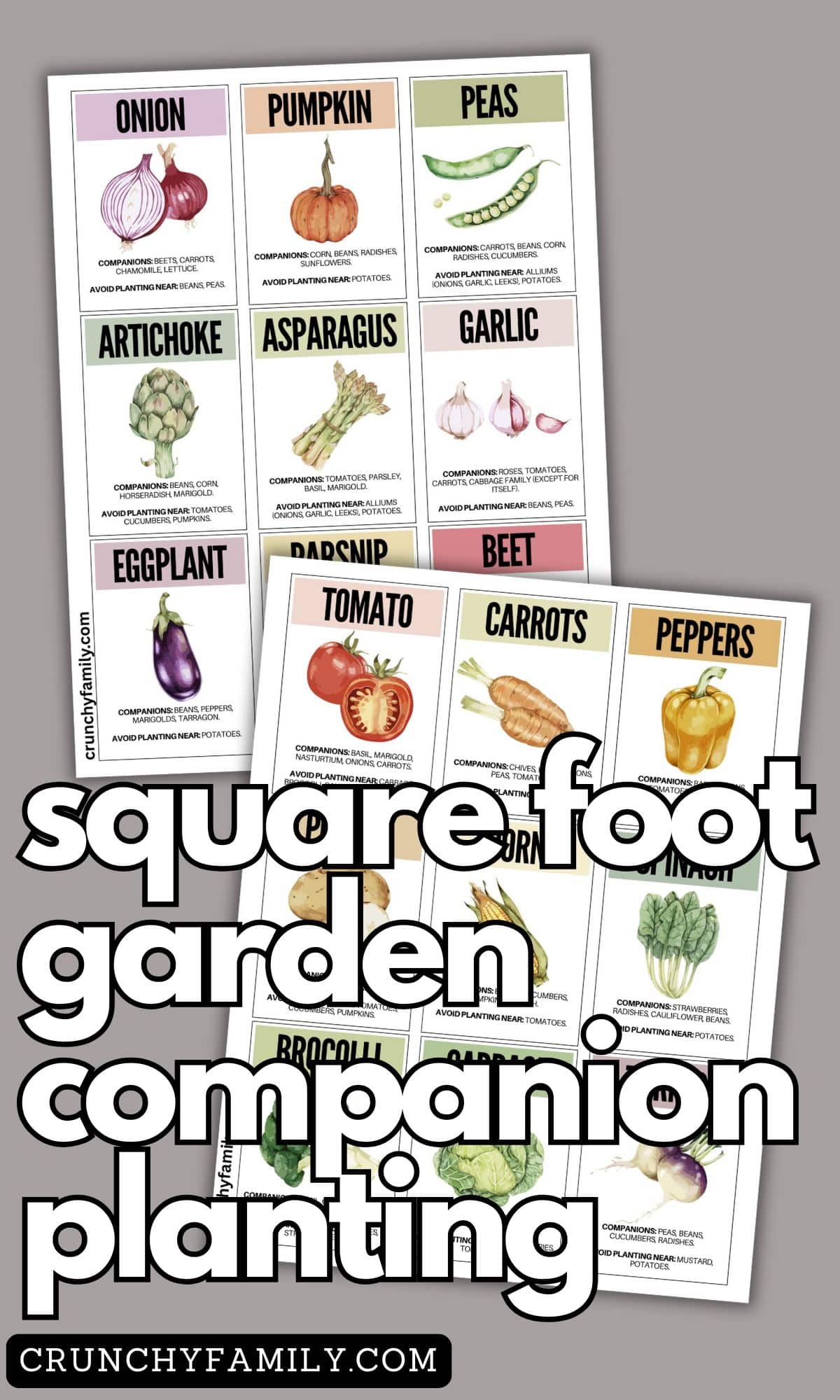If you’re just getting into square foot gardening for the first year or looking for a fresh way to plan your small space vegetable garden, you’re going to love this companion planting chart!
At Crunchy Family, we’re all about growing your own food in the best possible way, even if you’re working with limited space or raised beds instead of a traditional row garden.
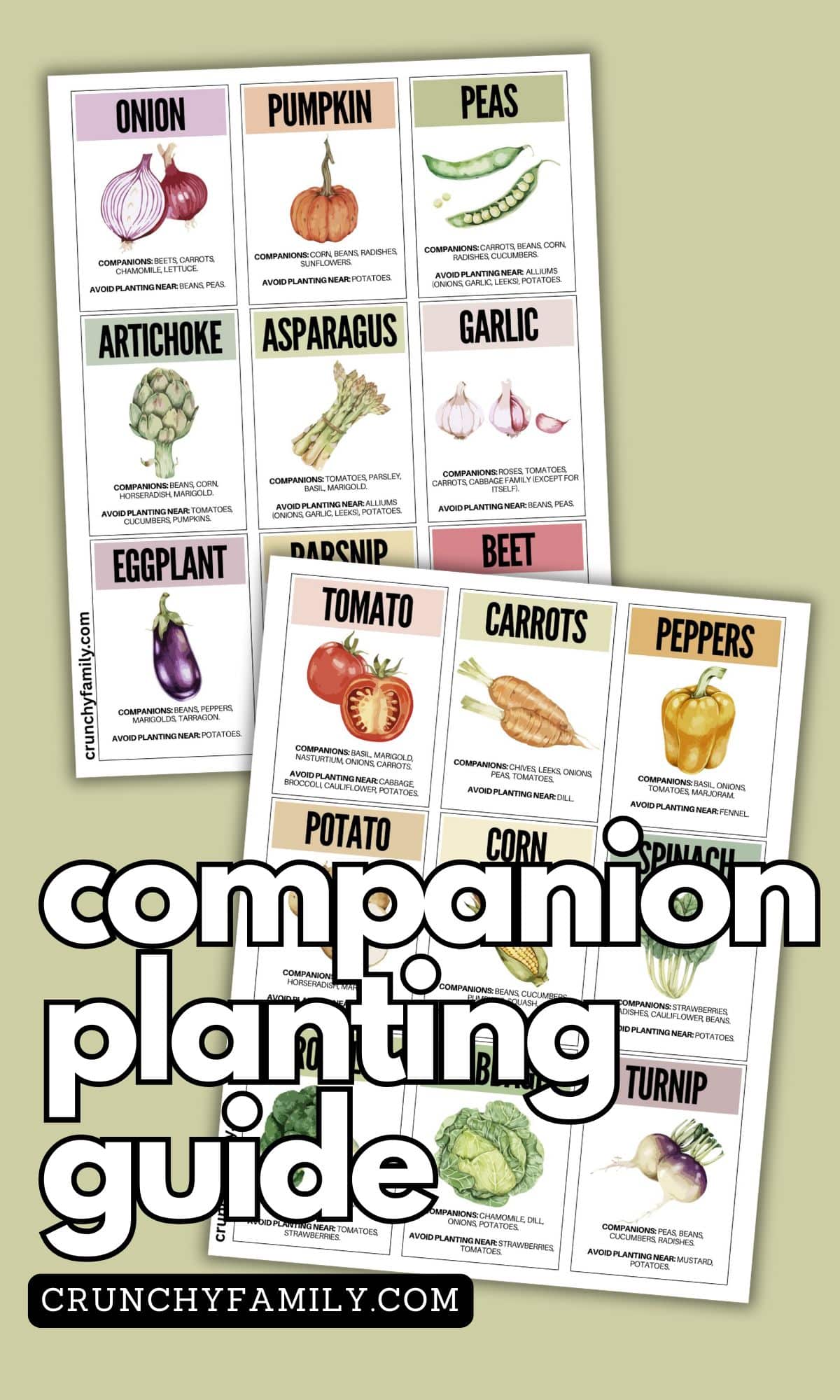
This free printable is designed as a quick companion planting guide helping you choose the right plants to grow side by side for a bountiful harvest, natural pest control, and the benefits of companion planting. Whether you’re dealing with spider mites, trying to attract beneficial insects like parasitic wasps*, or just figuring out the right number of plants per square foot, this chart is the perfect way to make the most of your garden and by using natural and organic methods like companion planting you can avoid synthetic pesticides.
Using the principles made popular by Mel Bartholomew and the Square Foot Gardening Foundation, this is a new way to garden that requires less space, less hard work, and brings more produce from your growing season.
*Parasitic wasps – doesn’t sound all that appealing does it? But YES these are beneficial for your garden and here’s why. They control pests naturally. Parasitic wasps lay their eggs inside or on the bodies of common garden pests like aphids, caterpillars, whiteflies, and even tomato hornworms. When the larvae hatch, they consume the pest from the inside out. It sounds brutal, but it’s an effective and natural form of biological pest control.
They reduce the need for sprays: Because they target specific pests, parasitic wasps help keep your garden balanced without disrupting the ecosystem like broad-spectrum insecticides might. This is especially helpful in a square foot garden, where you’re working in a smaller space and want to preserve beneficial insects.
Once established, they’ll patrol your garden season after season. This gives you an ongoing natural defense system against pests like cabbage worms, armyworms, and aphids.
Now that’s cleared up, let’s get into the details of each of the vegetables. This is also fantastic information to get our children familiar with at a young age, so definitely get them involved with growing your vegetables and planning out where to plant each one. This information will empower them to be self sufficient as they grow.
How to Use This Companion Planting Chart
Each card on our printable shows a type of vegetable, along with its companion plants and a short list of what not to plant nearby. This is crucial if you want to avoid pest damage, boost soil moisture, and keep your garden disease-free. Whether you’re planting in a raised garden bed, concrete blocks, or a smaller space container, proper plant spacing and pairings make all the difference.
Now here’s the full list, organized by vegetable for easy reference!
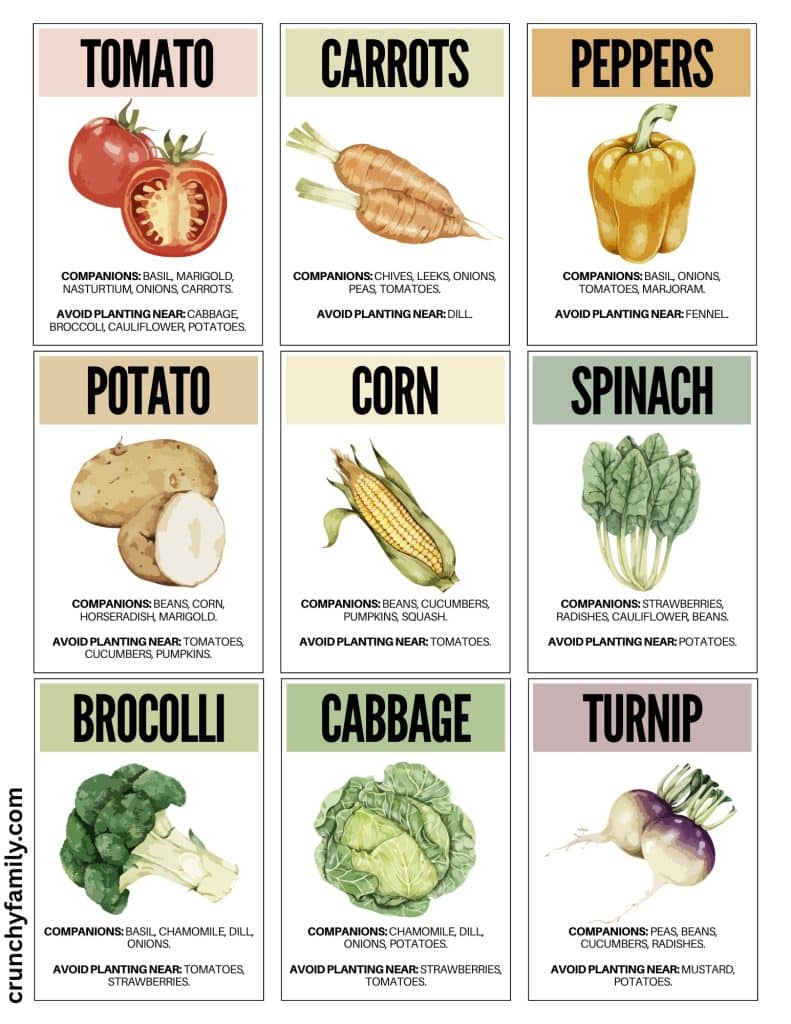
Tomato
Companions: Basil, marigold, nasturtium, onions, carrots
Avoid planting near: Cabbage, broccoli, cauliflower, potatoes
Carrots
Companions: Chives, leeks, onions, peas, tomatoes
Avoid planting near: Dill
Peppers
Companions: Basil, onions, tomatoes, marjoram
Avoid planting near: Fennel
Potato
Companions: Beans, corn, horseradish, marigold
Avoid planting near: Tomatoes, cucumbers, pumpkins
Corn
Companions: Beans, cucumbers, pumpkins, squash plants
Avoid planting near: Tomatoes
Spinach
Companions: Strawberries, radishes, cauliflower, beans
Avoid planting near: Potatoes
Broccoli
Companions: Basil, chamomile, dill, onions
Avoid planting near: Tomatoes, strawberries
Cabbage
Companions: Chamomile, dill, onions, potatoes
Avoid planting near: Strawberries, tomatoes
Turnip
Companions: Peas, beans, cucumbers, radishes
Avoid planting near: Mustard, potatoes
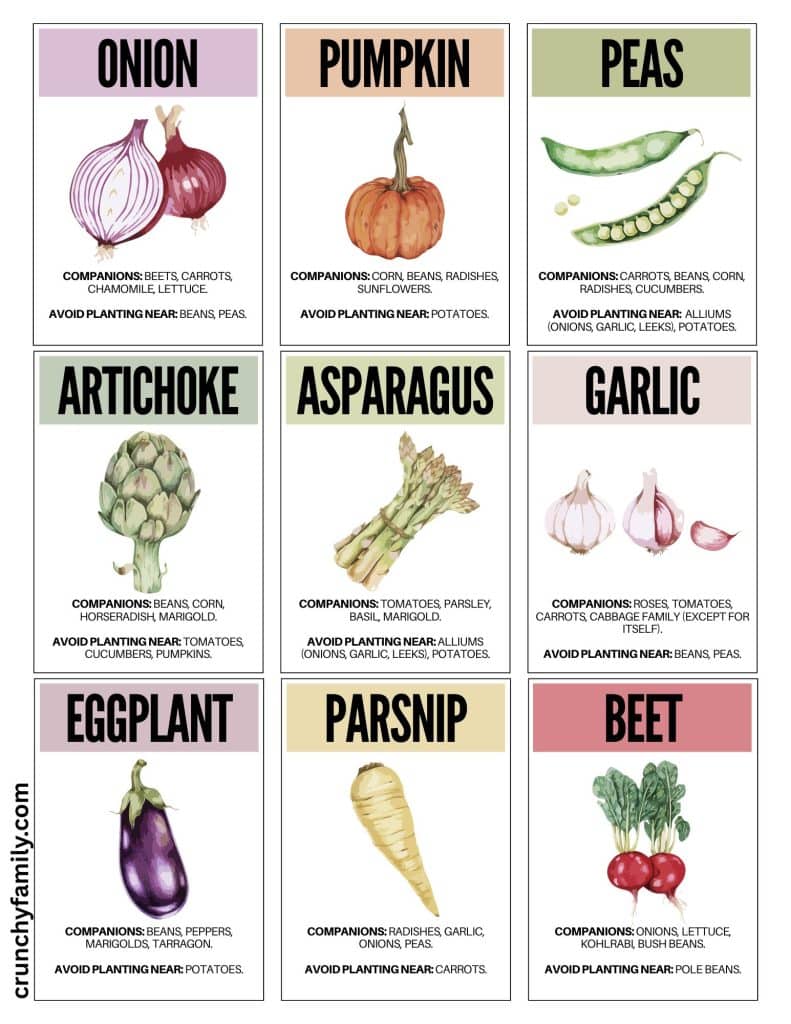
Onion
Companions: Beets, carrots, chamomile, lettuce
Avoid planting near: Beans, peas
Pumpkin
Companions: Corn, beans, radishes, sunflowers
Avoid planting near: Potatoes
Peas
Companions: Carrots, beans, corn, radishes, cucumbers
Avoid planting near: Alliums (onions, garlic, leeks), potatoes
Artichoke
Companions: Beans, corn, horseradish, marigold
Avoid planting near: Tomatoes, cucumbers, pumpkins
Asparagus
Companions: Tomatoes, parsley, basil, marigold
Avoid planting near: Alliums (onions, garlic, leeks), potatoes
Garlic
Companions: Roses, tomatoes, carrots, cabbage family (except for itself)
Avoid planting near: Beans, peas
Eggplant
Companions: Beans, peppers, marigolds, tarragon
Avoid planting near: Potatoes
Parsnip
Companions: Radishes, garlic, onions, peas
Avoid planting near: Carrots
Beet
Companions: Onions, lettuce, kohlrabi, bush beans
Avoid planting near: Pole beans
Example Square Foot Garden Layout
If you’re not sure where to start with companion planting, this example square foot garden layout is a simple way to visualize how it all works. E
ach of the 16 squares represents one foot of growing space in a raised bed, the classic format popularized by the Square Foot Gardening method. We’ve filled the grid with a mix of good companions like tomato and basil, peppers and marigold, corn and cucumber, and more.
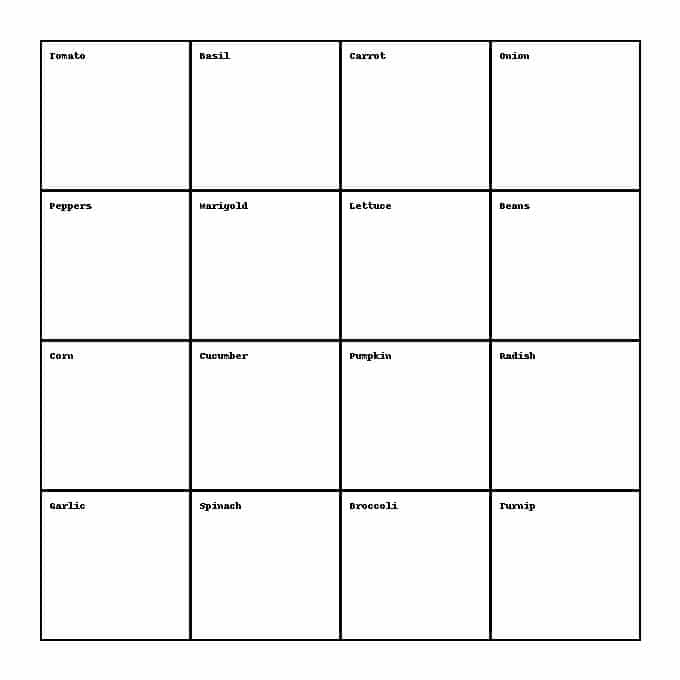
These combinations help support healthy growth, reduce pest damage, and make the most of your small area. Use this as a guide to map out your own garden and enjoy the benefits of companion planting, even in limited space.
Why Companion Planting Works (and Why It’s a Good Idea!)
Companion planting isn’t just an old wives’ tale, it’s a time-tested method with real benefits. From attracting beneficial predatory insects like parasitic wasps to creating a living mulch that preserves soil moisture, it can do a little bit of everything.
Pairing different plants the right way can:
- Boost crop protection naturally
- Improve your soil mix without synthetic inputs
- Reduce the need for pest control sprays
- Enhance yield in a smaller area
- Help you get the most out of your new container or raised bed
And when you’re dealing with a small amount of space, like in square-foot gardening, companion planting is one of the best ways to pack in different vegetables while still giving them the right spacing for healthy root systems and minimal plant diseases.
Download the Companion Planting Cards
This guide with companion planting cards is available as a free downloadable printable, created just for Crunchy Family readers.
Terms of use: This companion planting guide is free for personal use and educational use, not for commercial use.
Click below to download the pdf file. If you see a locked content widget from Grow, all you need to do is drop your email and the file will display. This is totally free and gives you the opportunity to join our email list.
You can print it out and keep it handy as you plan your new square-foot garden or raised bed this season.
Perfect for referring to and sketching out your grid on graph paper, labeling wide rows, or referring to as you pick plants from your local nursery.
There are so many good reasons to try companion planting. This simple plan works well with all garden sizes and is especially helpful in limited space or when growing in a smaller space like a patio or balcony.
It does take a little research and maybe some extra effort upfront, but the good news is, the rewards are huge: less pest damage, more food, and a more balanced, organic way to grow your own food. It also makes growing your own produce more accessible to families who don’t have a whole bunch of land to grow on.
If you’ve struggled with traditional row gardening in the past or you’re trying to grow a lot of produce in just a few square feet, this is a great way to take a new approach and get great results.
So if you’re wondering about growing squash plants next to tomatoes, or how many green beans to fit in your square-foot garden — this companion planting chart has the answers you need.
Related Posts
Looking for more simple natural living tips, natural cleaning methods, and free printables? These posts are packed with ideas to support your small space garden, from kid-friendly activities to DIY guides using what you already have at home.
Check out these resources to keep your family and home thriving all season long!
- Non Toxic Household Swaps You Need to Start Today
- How to Naturally Remove Pesticides from Apples
- Homemade Produce Wash Recipe – A Natural Way to Clean Your Fruits and Vegetables
- Printable 30 Day Declutter Challenge
- Gmo Free Food List – Brands That Do and Don’t Use GMOs
- 7 Hands On Butterfly Activities for Wild Kids
- Easy Vegetable Coloring Pages
Share This Post
If you found this blog post helpful, please share it with other gardeners or pin it for later. Whether you’re into gardening for sustainability, better health, or just the joy of growing, this is a handy resource for every season.
And don’t forget to tag us if you use the printable — we’d love to see your garden grow!
